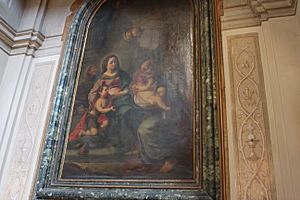Francisco Preciado facts for kids
Francisco Preciado de la Vega (born 1713, died 1789) was a Spanish painter. He spent most of his life working in Italy, especially in Rome. He was also part of many art groups and academies in Rome, often holding important positions.
Life of a Painter
Francisco Preciado was born in Écija, a town in Spain. He first learned to paint from Domingo Martinez. Later, a court painter named Francisco de Vieyra suggested he go to Rome to study art. So, in 1732, Preciado moved to Rome with a sculptor named Felipe de Castro.
In Rome, he joined the art school of Sebastiano Conca. Preciado painted several artworks there. One important painting was a Holy Family for the church of Santi Quaranta Martiri e San Pasquale Baylon, Rome. He painted both religious scenes and portraits of people. In 1740, King Philip V of Spain gave him a yearly payment of 500 ducats. This was because a Spanish minister in Rome, Cardinal Troiano Acquaviva d'Aragona, recommended him.
From 1744 to 1750, Preciado helped design special structures for the Chinea celebrations in Rome. These were big, temporary buildings put up for the yearly festival. He also worked on illustrations for books.
In 1750, Preciado married an Italian artist named Caterina Cherubini. She was a miniature painter, meaning she painted very small, detailed pictures.
In 1758, Preciado became the director of a new Spanish art school in Rome. He got this job partly because he had written reports about how art academies in Europe worked. These reports helped create the rules for the art academy in Madrid, Spain. As director, he sometimes helped Spanish artists who were new to Rome and struggling financially. He kept this important job for the rest of his life.
In 1760, he was named the official painter for King Ferdinand VI for a time. From 1764 to 1767, he was the principe (leader) of the Accademia di San Luca in Rome. He was also a member of the Spanish Academia de San Fernando. One of his students was Francesco Manno.
In 1788, Preciado wrote a book about painting called Arcadia Pittorica. In the same year, he and his wife were made honorary members of the Accademia Clementina in Bologna.
Francisco Preciado lived most of his life in Rome. He died there in 1789 and was buried at Santa Susanna church.
Known Artworks
Francisco Preciado de la Vega's painting career in Rome was closely connected to religious groups and Spanish diplomats. He worked in a very busy art world. Also, being involved with many art groups in Rome meant he had less time to paint. Here is a list of some of his known works:
- Miracle of Santa Casilda (1738)
- Allegory of Peace, (Real Academia de Bellas Artes de San Fernando)
- Allegory of History, (RABASF)
- The sacrifice of Jefte's daughter (1746), (RABASF)
- Judah and Tamar (1750), (RABASF)
- Mass of San Juan de Mata (1757)
- Virgen del Pilar with the Apostle Santiago and Saint Vicente Ferrer (1768) Santa Maria in Monserrato degli Spagnoli
Images for kids
See also
 In Spanish: Francisco Preciado de la Vega para niños
In Spanish: Francisco Preciado de la Vega para niños







